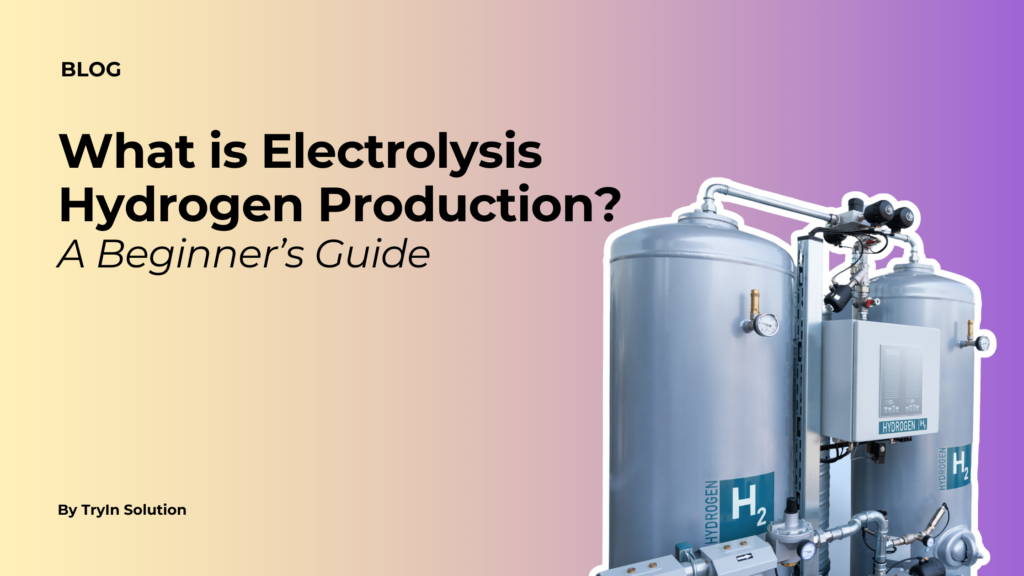
As the world transitions toward cleaner energy solutions, hydrogen has emerged as a promising alternative to traditional fossil fuels. One of the most sustainable methods of producing hydrogen is through electrolysis. But what exactly is electrolysis hydrogen production, and why is it important? This beginner’s guide aims to answer these questions and shed light on its potential to revolutionize the energy landscape.
Understanding Electrolysis Hydrogen Production
Electrolysis is a process that uses electricity to split water ( H₂O ) into its basic components: hydrogen ( H₂ ) and oxygen ( O₂ ). When the electricity used comes from renewable energy sources like wind or solar, the hydrogen produced is often referred to as “green hydrogen” due to its minimal environmental impact.
The Basic Process
- Electrolyzer: The device used for electrolysis consists of an anode and a cathode submerged in water, separated by an electrolyte.
- Electric Current: A direct current (DC) is passed through the water.
- Separation: Hydrogen gas collects at the cathode, while oxygen is released at the anode.
This simple yet effective process is at the heart of electrolysis hydrogen production, offering a clean and efficient way to generate hydrogen for various applications.
Why is Electrolysis Hydrogen Production Important?
1. A Cleaner Energy Source
Hydrogen produced via electrolysis emits no greenhouse gases during its use, making it an excellent substitute for fossil fuels in sectors like transportation, manufacturing, and power generation.
2. Energy Storage
Hydrogen acts as a powerful energy carrier, enabling the storage of excess energy generated by renewable sources. This addresses the intermittency issues of solar and wind power.
3. Industrial Applications
Industries like steel production, ammonia manufacturing, and chemical refining benefit from the high purity hydrogen generated through electrolysis.
Types of Electrolyzers Used in Hydrogen Production
1. Alkaline Electrolyzers
- How It Works: Uses a liquid alkaline electrolyte, such as potassium hydroxide, to conduct electricity.
- Advantages: Proven technology, cost-effective, and scalable.
- Disadvantages: Lower efficiency compared to advanced systems.
2. Proton Exchange Membrane (PEM) Electrolyzers
- How It Works: Utilizes a solid polymer electrolyte to separate hydrogen and oxygen.
- Advantages: Higher efficiency and compact design.
- Disadvantages: More expensive due to the use of precious metals like platinum.
3. Solid Oxide Electrolyzers
- How It Works: Operates at high temperatures to split water molecules.
- Advantages: Extremely efficient, especially when integrated with industrial heat sources.
- Disadvantages: Still under development and requires further cost reductions.
Applications of Hydrogen from Electrolysis
1. Clean Transportation
Hydrogen-powered fuel cells are being increasingly used in vehicles, providing a zero-emission alternative to gasoline and diesel engines.
2. Power Generation
Hydrogen can be burned or used in fuel cells to generate electricity, making it a flexible energy source for both grid and off-grid applications.
3. Industrial Uses
In industries requiring high temperatures, such as steelmaking, hydrogen offers a cleaner fuel alternative to coal.
4. Export Potential
Countries investing in electrolysis hydrogen production can export green hydrogen to nations seeking to decarbonize their energy systems.
Challenges in Electrolysis Hydrogen Production
1. High Energy Requirements
Electrolysis requires significant amounts of electricity, making its efficiency directly dependent on the energy source used.
2. Cost Factors
The cost of electrolyzers and renewable energy infrastructure is still relatively high, which impacts the overall affordability of green hydrogen.
3. Scaling Up
While the technology is promising, scaling up to meet global energy demands requires further innovation and investment.
The Future of Electrolysis Hydrogen Production
The global push toward sustainability has positioned electrolysis hydrogen production as a cornerstone of the energy transition. Governments and organizations worldwide are investing in research, infrastructure, and policies to support the adoption of green hydrogen. With advancements in electrolyzer technology and renewable energy integration, the cost of hydrogen production is expected to decrease, making it more accessible across industries.
Why Choose TryIn Solution for Hydrogen Solutions?
At TryIn Solution, we understand the transformative potential of green hydrogen and are dedicated to supporting businesses in adopting sustainable energy practices. From providing cutting-edge technology to offering expert guidance, we help you harness the benefits of electrolysis hydrogen production effectively and efficiently.
Conclusion
Electrolysis hydrogen production is a game-changing technology that promises to redefine how we produce and use energy. By offering a clean, sustainable, and versatile energy source, it addresses some of the most pressing challenges of our time, from reducing carbon emissions to ensuring energy security. As we move toward a greener future, investing in this innovative solution will be pivotal for industries and governments alike.
Explore how TryIn Solution can help you integrate hydrogen solutions into your operations. Contact us today to learn more!